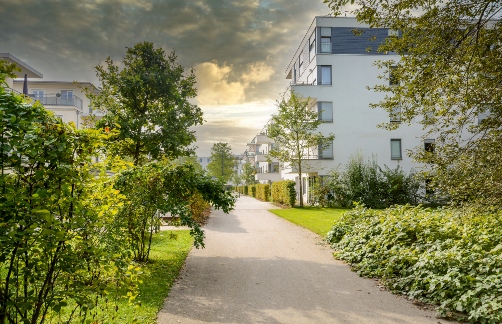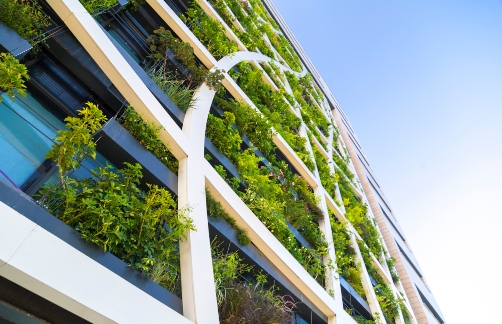BREEAM Version 7 set to embrace new Biodiversity Net Gain legislation
As pressure mounts to take action to protect our planet from the climate crisis, many aspects of construction can contribute to holistic sustainability in the built environment.
Biodiversity Net Gain (BNG), or increasing the abundance of plants and animals in an area, is one method that preserves existing habitats, whilst adding resilience to ecosystems that provide life-sustaining processes, like agriculture and pollution reduction. It also aligns construction with sustainable practices and regulations to mitigate the impact of the built environment on biodiversity.
To preserve and reinforce the biodiversity of land that assets occupy, the UK government is making BNG mandatory for all England-based developers during 2024.
What is Biodiversity Net Gain?
BNG is a commitment to leaving the environment in an improved state. This ensures that the ecological value of an area increases over time or – in this case – over the course of a building project.
The new regulations require a net gain of 10% biodiversity for newly constructed commercial, residential and industrial assets.
Most developments will adopt BNG from 12th February 2024, with smaller sites following from 2nd April of the same year. This phased approach allows for the gradual integration of BNG principles. It gives developers and stakeholders time to adapt their current practices and embrace the positive changes BNG brings to construction and real estate.

Benefits of Biodiversity Net Gain
BNG has environmental, social, and economic benefits.
Environmental benefits:
BNG serves as a protector of the natural world, to help us preserve ecosystems. By safeguarding habitats, it shields species, fostering resilient and healthy ecosystems. BNG also contributes to cleaner air and water by preserving natural habitats crucial for filtering human-made pollutants.
Social benefits:
BNG’s impact extends beyond ecology, as it significantly enhances community well-being. The inclusion of green spaces in urban developments creates accessible sanctuaries for residents – promoting better physical and mental health. BNG also provides educational opportunities, allowing communities to interact with and learn from the environment.
Economic benefits:
BNG can create job opportunities, especially in areas related to sustainable landscaping, habitat restoration, and ecological consultancy. Beyond job creation, BNG contributes to increased property values by creating desirable living environments with an improved quality of life. Crucially, biodiversity preservation plays a role in ensuring civil security, as healthy ecosystems support agriculture, pollination and other life-sustaining ecosystem services. Without these, many foods, medicines and materials would not exist for humans to use.
Biodiversity Net Gain and its impact on the construction industry
The implementation of BNG reshapes how the construction industry operates and places fresh responsibility on project teams.
New responsibilities:
BNG requires project teams to look beyond conventional construction considerations. In addition to delivering functional assets, they must now ensure a positive impact on local biodiversity. This involves careful planning, integration of green spaces, and the use of ecologically sensitive construction methods.
Mandatory status:
The mandatory nature of BNG, effective from 12th February 2024, marks a significant change for the construction industry. Compliance is a fundamental aspect of project development. Following BNG requirements affects project timelines, how much it costs, and the overall approach – with non-compliance resulting in legal consequences. Management of conflicting objectives requires a considered approach that balances legislation with stakeholder demands
BREEAM, SmartWaste and Biodiversity Net Gain
The early integration of BNG principles into construction projects is key; BREEAM eases any difficulties faced due to the new legislation. By considering biodiversity from project conception, BREEAM ensures that ecology is an integral part of a development’s DNA – rather than an afterthought. In England, BREEAM is providing local authorities with a structured process and framework for achieving net biodiversity gain.
Metrics, measurement tools, and compliance support:
BREEAM provides project teams with the tools needed to navigate the complexities of BNG. Offering detailed metrics and measurement tools, BREEAM helps measure biodiversity losses and gains. BREEAM also offers compliance support, helping stakeholder teams align their projects with BNG requirements. Large projects, which are more likely to harm local ecology, require the input of an accredited ecologist. BREEAM ensures the early detection of issues arising from legislation to minimise costs and impact.

BREEAM Version 7
Due to launch later in 2024, version 7 of BREEAM will enable clients and asset managers to improve the biodiversity net gain of their projects. Designed to credit BNG, BREEAM assists projects in meeting the new legislation.
BREEAM Version 7 (V7) includes credits that make sure the new laws are easily understood and followed. Highlights include:
- Increase % of BNG in accordance with new regulations: BREEAM V7 emphasises a higher percentage of BNG aligning with the updated regulations to amplify the positive impact on local ecosystems.
- DEFRA Metric Tool replaces LUE Tool: in a move towards efficiency and accuracy, the DEFRA Metric Tool replaces the Land Use and Ecology (LUE) tool. This change streamlines the assessment process, ensuring reliable and reproduceable metrics.
- Allows the use of the Small Site Metric (SSM): recognising the diversity of building projects, BREEAM Version 7 introduces the option to employ the Small SSM, providing flexibility in assessment methods.
- Calculation methodology where the baseline is zero: sites with a baseline of zero are exempt from mandatory BNG, however still remain subject to essential planning policy requirements for achieving a net gain in biodiversity. BREEAM V7 provides a methodology to enable this, ensuring observance of BNG legislation regardless of the initial baseline value.
Long-term monitoring and maintenance:
Beyond the construction phase, BREEAM’s role extends into long-term monitoring and maintenance. It provides accountability, ensuring that the biodiversity gains achieved during construction persist over time. Using BREEAM protects the environment above legislative requirements – resulting in outcomes beneficial to our planet and the people who live on it.
Find out more about biodiversity in BREEAM
